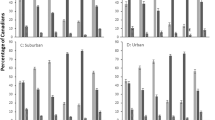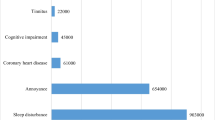Abstract
Road traffic noise is affecting the exposed population through its detrimental effects. This study was conducted in urban zones of Peshawar, Khyber Pakhtunkhwa, Pakistan, to analyze causal relationship between noise and subjective health complaints with a special focus on psychological symptoms. A 12-h (LAeq) noise survey conducted at different locations (n = 57) indicated a noise range of 46.3–86.3 dB (A). A questionnaire survey was conducted from local residents (n = 500), students (n = 500), policemen (n = 500), shopkeepers (n = 500), and drivers (n = 500) exposed to road traffic noise and analyzed through structure equation modeling (SEM). Different models were prepared and a modified model obtained the acceptable model fit, i.e., chi-square 0.093, χ2/df 1.286, comparative fit index 0.986, goodness of fit index 0.966, normed fit index 0.943, Tucker-Lewis index 0.977, and root mean square error of approximation 0.034. The modified model gives not only the information about direct but also indirect effects of noise on the exposed population. Adding on, the model clearly indicates that sensitivity to noise has strong relationship with subjective health complaints (headache, exhaustion, and psychological symptoms such as annoyance, difficulty concentrating, ill temper, and anxiety) than profession, age, location, and gender. Duration of exposure to road traffic noise has an important role in increasing the frequency of subjective health issues. The model is important in depicting that sensitivity to noise may produce subjective health complaints (standardized parameter estimates of 0.12 and 0.29) but the mediator has much stronger positive path estimates (0.59). The modified model sought to discover and explicate the underlying mechanism of an observed relationship existing between the selected dependent and an independent variable through the identification of the mediator variables.





Similar content being viewed by others
References
Akan Z, Yilmaz, A., Özdemir, O., Selvi, Y., Korpinar, M.A. 2012. Noise pollution, psychiatric symptoms and quality of life: noise problem in the east region of Turkey. In: 20th European Congress of Psychiatry
Baliatsas C, van Kamp I, Swart W, Hooiveld M, Yzermans J (2016) Noise sensitivity: symptoms, health status, illness behavior and co-occurring environmental sensitivities. Environ Res 150:8–13
Basner M, Babisch W, Davis A, Brink M, Clark C, Janssen S et al (2014) Auditory and non-auditory effects of noise on health. Lancet 383:1325–1332
Brown AL, Van Kamp I (2017) Who environmental noise guidelines for the European region: a systematic review of transport noise interventions and their impacts on health. Int J Env Res Public Health 14:873
Brown MW, Cudeck R. 1993. Alternative ways of assessing model fit. Testing structural equation models 154:136–162
Byrne BM. 2012. A primer of LISREL: basic applications and programming for confirmatory factor analytic models. Springer Science & Business Media
Clark C, Paunovic K (2018) Who environmental noise guidelines for the European region: a systematic review on environmental noise and cognition. Int J Env Res Public Health 15:285
Dzhambov A, Tilov B, Markevych I, Dimitrova D (2017) Residential road traffic noise and general mental health in youth: the role of noise annoyance, neighborhood restorative quality, physical activity, and social cohesion as potential mediators. Environ Int 109:1–9
Essandoh PK, Armah FA (2011) Determination of ambient noise levels in the main commercial area of Cape Coast, Ghana. Res J Environ Earth Sci 3:637–644
Fecht D, Hansell AL, Morley D, Dajnak D, Vienneau D, Beevers S, Toledano MB, Kelly FJ, Anderson HR, Gulliver J (2016) Spatial and temporal associations of road traffic noise and air pollution in London: implications for epidemiological studies. Environ Int 88:235–242
Fiedler PEK, Zannin PHT (2015) Evaluation of noise pollution in urban traffic hubs; noise maps and measurements. Environ Impact Assess Rev 51:1–9
Fields JM (1993) Effect of personal and situational variables on noise annoyance in residential areas. J Acoust Soc Am 93:2753–2763
Fyhri A, Klæboe R (2006) Direct, indirect influences of income on road traffic noise annoyance. J Environ Psychol 26:27–37
Fyhri A, Klæboe R (2009) Road traffic noise, sensitivity, annoyance and self-reported health-a structural equation model exercise. Environ Int 35:91–97
Garoum M, Laaroussi N, Ammar A. 2015. Road traffic noise analysis and annoyance in Moroccan cities: case of Rabat
Gholami A, Nasiri P, Monazzam M, Gharagozlou A, Monavvari SM, Afrous A (2012) Evaluation of traffic noise pollution in a central area of Tehran through noise mapping in gis. Adv Environ Biol 6:2365–2371
Goines L, Hagler L (2007) Noise pollution: a modern plague. South Med J 100:287–294
Griffiths I, Langdon FJ (1968) Subjective response to road traffic noise. J Sound Vibrat 8:16–32
Guski R, Schreckenberg D, Schuemer R (2017) Who environmental noise guidelines for the European region: a systematic review on environmental noise and annoyance. Int J Env Res Public Health 14:1539
Halperin D (2014) Environmental noise and sleep disturbances: a threat to health? Sleep Sci 7:209–212
Hatfield J, Job RS, Hede AJ, Carter NL, Peploe P, Taylor R et al (2002) Human response to environmental noise: the role of perceived control. Inter J Behav Med 9:341–359
Heinonen-Guzejev M, Vuorinen HS, Mussalo-Rauhamaa H, Heikkilä K, Koskenvuo M, Kaprio J (2007) The association of noise sensitivity with coronary heart and cardiovascular mortality among Finnish adults. Sci Total Environ 372:406–412
Héritier H, Vienneau D, Frei P, Eze IC, Brink M, Probst-Hensch N et al (2014) The association between road traffic noise exposure, annoyance and health-related quality of life (HRQOL). Int J Env Res Public Health 11:12652–12667
Hume KI, Brink M, Basner M (2012) Effects of environmental noise on sleep. Noise Health 14:297–302
Jagniatinskis A, Fiks B, Zaporozhets O, van Oosten N (2016) Annual noise assessment in the vicinity of airports with different flights’ intensity. App Acoust 101:168–178
Jamir L, Nongkynrih B, Gupta SK (2014) Community noise pollution in urban India: need for public health action. Indian J Community Med 39:8–12
Joshi SK, Devkota S, Chamling S, Shrestha S (2003) Environmental noise induced hearing loss in Nepal. Kathmandu University Med J 1:177–183
Khaiwal R, Singh T, Tripathy JP, Mor S, Munjal S, Patro B et al (2016) Assessment of noise pollution in and around a sensitive zone in North India and its non-auditory impacts. Sci Total Environ 566:981–987
Kim K, Shin J, Oh M, Jung J-K (2019) Economic value of traffic noise reduction depending on residents’ annoyance level. Environ Sci Pollut Res 26:7243–7255
Kim M, Chang SI, Seong JC, Holt JB, Park TH, Ko JH, Croft JB (2012) Road traffic noise: annoyance, sleep disturbance, and public health implications. Am J Prev Med 43:353–360
Lee SC, Hong JY, Jeon JY (2015) Effects of acoustic characteristics of combined construction noise on annoyance. Build Environ 92:657–667
Miedema HM, Vos H (1999) Demographic and attitudinal factors that modify annoyance from transportation noise. J Acoust Soc Am 105:3336–3344
Murthy VK, Majumder AK, Khanal SN, Subedi DP (2007) Assessment of traffic noise pollution in Banepa, a semi urban town of Nepal. Kathmandu University J Sci Eng Technol 3:12–20
Muzet A (2007) Environmental noise, sleep and health. Sleep Med Rev 11:135–142
Nivison ME, Endresen IM (1993) An analysis of relationships among environmental noise, annoyance and sensitivity to noise, and the consequences for health and sleep. J Behav Med 16:257–276
Okokon E, Turunen A, Ung-Lanki S, Vartiainen A-K, Tiittanen P, Lanki T (2015) Road-traffic noise: annoyance, risk perception, and noise sensitivity in the Finnish adult population. Int J Env Res Public Health 12:5712–5734
Okura Y, Urban LH, Mahoney DW, Jacobsen SJ, Rodeheffer RJ (2004) Agreement between self-report questionnaires and medical record data was substantial for diabetes, hypertension, myocardial infarction and stroke but not for heart failure. J Clin Epidemiol 57:1096–1103
Ongel A, Sezgin F (2016) Assessing the effects of noise abatement measures on health risks: a case study in Istanbul. Environ Impact Assess Rev 56:180–187
Pathak V, Tripathi B, Kumar MV (2008) Evaluation of traffic noise pollution and attitudes of exposed individuals in working place. Atmos Environ 42:3892–3898
Persson R, Björk J, Ardö J, Albin M, Jakobsson K (2007) Trait anxiety and modeled exposure as determinants of self-reported annoyance to sound, air pollution and other environmental factors in the home. Int Arch Occup Environ Health 81:179–191
Rahmani S, Mousavi SM, Kamali MJ (2011) Modeling of road-traffic noise with the use of genetic algorithm. Appl Soft Computing 11:1008–1013
Ristovska G, Lekaviciute J (2013) Environmental noise and sleep disturbance: research in central, eastern and south-eastern Europe and newly independent states. Noise Health 15:6
Ross Z, Kheirbek I, Clougherty JE, Ito K, Matte T, Markowitz S, Eisl H (2011) Noise, air pollutants and traffic: continuous measurement and correlation at a high-traffic location in New York City. Environ Res 111:1054–1063
Schreckenberg D, Griefahn B, Meis M (2010) The associations between noise sensitivity, reported physical and mental health, perceived environmental quality, and noise annoyance. Noise Health 12:7
Shrout PE, Bolger N (2002) Mediation in experimental and nonexperimental studies: new procedures and recommendations. Psychol Methods 7:422
Singh D, Kumar A, Kumar K, Singh B, Mina U, Singh BB, Jain VK (2016) Statistical modeling of O3, NOx, CO, PM2.5, VOCs and noise levels in commercial complex and associated health risk assessment in an academic institution. Sci Total Environ 572:586–594
Smith A (2003) The concept of noise sensitivity: implications for noise control. Noise Health 5:57
Stansfeld SA (1992) Noise, noise sensitivity and psychiatric disorder: epidemiological and psychophysiological studies. Psychol Med Monogr Suppl 22:1–44
Stansfeld SA, Matheson MP (2003) Noise pollution: non-auditory effects on health. Br Med Bull 68:243–257
Steiger JH (1990) Structural model evaluation and modification: an interval estimation approach. Multivar Behavioral Res 25:173–180
Swain K, Goswami S (2013) Integration and comparison of assessment and modeling of road traffic noise in Baripada town, India. Int J Energy Environ 4:303–310
Sygna K, Aasvang GM, Aamodt G, Oftedal B, Krog NH (2014) Road traffic noise, sleep and mental health. Environ Res 131:17–24
Tripathy DP. 1999. Noise pollution. APH Publishing
USAID/PAIMAN. 2009. District health profile; District Peshawar
Van Kamp I, Job RS, Hatfield J, Haines M, Stellato RK, Stansfeld SA (2004) The role of noise sensitivity in the noise–response relation: a comparison of three international airport studies. J Acoust Soc Am 116:3471–3479
Vijayalakshmi K. (2003) Noise pollution. In: Proceedings of the Third International Conference on Environment and Health, Chennai, India, 15-17 December, 2003, (Bunch MJ, Suresh VM, Kumaran TV eds)
Vogiatzis K (2012) Airport environmental noise mapping and land use management as an environmental protection action policy tool. The case of the Larnaka International Airport (Cyprus). Sci Total Environ 424:162–173
WHO. 2011. Burden of disease from environmental noise: quantification of healthy life years lost in Europe.World Health Organization
Wothge J, Belke C, Möhler U, Guski R, Schreckenberg D (2017) The combined effects of aircraft and road traffic noise and aircraft and railway noise on noise annoyance—an analysis in the context of the joint research initiative NORAH. Int J Env Res Public Health 14:871
Wu J, Zou C, He S, Sun X, Wang X, Yan Q (2019) Traffic noise exposure of high-rise residential buildings in urban area. Environ Sci Pollut Res 26:8502–8515
Zannin PHT, Engel MS, Fiedler PEK, Bunn F (2013) Characterization of environmental noise based on noise measurements, noise mapping and interviews: a case study at a university campus in Brazil. Cities 31:317–327
Funding
This paper is financially supported by the Higher Education Commission, Islamabad, Pakistan, under NRPU project “Acoustic Zoning, Mapping, and Modeling of Noise Pollution for Urban Zones of Peshawar Using GIS” (NRPU Project No. 5135).
Author information
Authors and Affiliations
Corresponding author
Ethics declarations
Conflict of interest
The authors declare that they have no conflict of interest.
Additional information
Responsible editor: Philippe Garrigues
Publisher’s note
Springer Nature remains neutral with regard to jurisdictional claims in published maps and institutional affiliations.
Electronic supplementary material
ESM 1
(DOCX 35 kb)
Rights and permissions
About this article
Cite this article
Nazneen, S., Raza, A. & Khan, S. Assessment of noise pollution and associated subjective health complaints and psychological symptoms: analysis through structure equation model. Environ Sci Pollut Res 27, 21570–21580 (2020). https://doi.org/10.1007/s11356-020-08655-x
Received:
Accepted:
Published:
Issue Date:
DOI: https://doi.org/10.1007/s11356-020-08655-x




